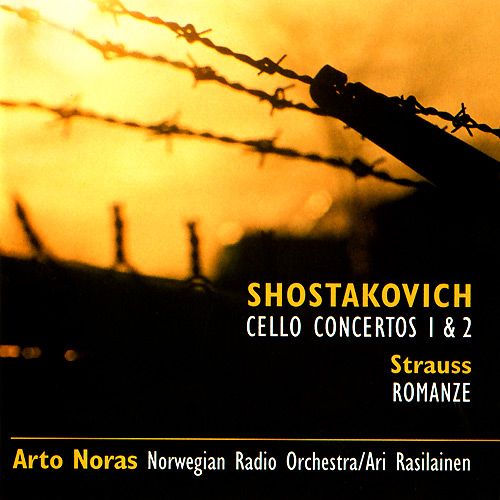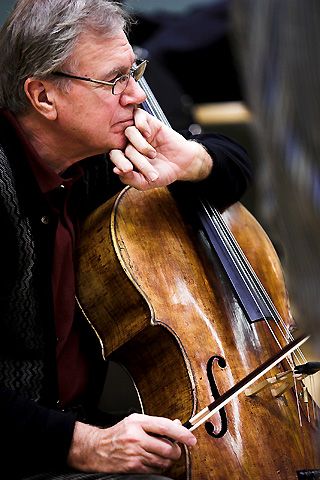wimpel69
11-07-2014, 02:58 PM
"This ideal coupling of the two Shostakovich cello concertos brings fresh,
clean-cut readings, totally assured and marked by many moments of poetry."
EAC-FLAC link below. This is my own rip. Complete artwork,
LOG and CUE files included. Do not share. Buy the original!
Please leave a "Like" or "Thank you" if you enjoyed this!
Dmitri Shostakovich composed the Cello Concerto No.1 in July 1959 and Mstislav Rostropovich introduced it
at Leningrad on October 4, with Yevgeny Mravinsky conducting. It is lightly scored for double winds, piccolo, contrabassoon,
a single horn (no other brass), timpani, celesta, and strings.
Although a prolific composer in other forms, Shostakovich wrote only six concertos. If those for keyboard seem prevailingly
saucy and sun dappled, the four string concertos are somberly serious. Where there's any laughter at all, it sounds forced
and hollow. To lighten it (or try) only reinforces the "holy fool" (yurodivy) analogy that haunts Solomon Volkov's
Testimony, the posthumously alleged Memoirs of Dmitri Shostakovich.
When the First Cello Concerto was written with almost Mozartean speed, Stalin had been dead six years but not forgotten.
In 1958 Boris Pasternak was forced to decline a Nobel Prize for his anti-Stalinist novel, Doctor Zhivago, and then
was expelled from the Writers' Union. Ian MacDonald, in The New Shostakovich, concluded that Pasternak's humiliation
and subsequent persecution significantly influenced the First Cello Concerto. Volkov, on the other hand, gave no hint,
nor did Elizabeth Wilson in A Life Remembered. Most of what she included, anent the concerto, was Rostropovich's
celebration of himself, with this notable exception: "In the First Cello Concerto [M.R. speaking], Shostakovich alludes
to Stalin's favorite song, 'Suliko.' These allusions are undoubtedly not accidental, but...are camouflaged so craftily
that even I didn't notice them to begin with. The first time Dmitry Dmitriyevich hummed this passage through to me
[from the concluding rondo movement], he laughed and said, 'Slava, have you noticed?'"
Cello Concerto No. 1 is a major-key work in minor keys more often than not, recalling the mature Schubert's
subtle modulations. It was his first large-scale undertaking after the Eleventh Symphony a year earlier and one
of the works he quoted in his autobiographical Eighth String Quartet of 1960.
Shostakovich's last major work before his first heart-attack -- his first intimation of his own mortality -- was the
Second Cello Concerto. Composed in the early months of 1966, the Cello Concerto seems to have started
life as what Shostakovich called his Fourteenth Symphony. In the event, however, the work evolved into the
concerto, although the work's symphonic character was so pronounced that Shostakovich wrote to his friend Isaak
Glikman "...that the Second Concerto could have been called the Fourteenth Symphony with a solo cello part"
(Shostakovich, A Life, Laurel Fay, p. 247).
Although the work was conceived and composed prior to the deterioration of his health, the Second Cello
Concerto is, for the most part, a dark and ominous work with a long and introspective opening Largo and a
counter-balancing Allegretto finale, which is a sort of dusky barcarolle. Indeed, the work ends with the curious
"clock-work" percussion which closed the Fourth Symphony of 1935 and which would close the Fifteenth and final
symphony of 1971. Yet the work is not all gloomy: the central movement, also an Allegretto, is based in part
on a popular song of the '20s, "Pretzels, Who'll Buy my Pretzels?" Apparently, Shostakovich and some of his
close friends saw in the New Year of 1966 with a game of "Name that Tune" and Shostakovich played that tune
which he said was one of his favorites. One of the party guests was the cellist Mstislav Rostropovich, the
dedicatee and first performer of the Second Concerto.
Scored for pairs of winds with double bassoon, a pair of horns and of harps, plus a large percussion section,
Shostakovich's Second Concerto is a darkly lit work with flashes of light. The outer movements are rhapsodically
composed around pivotal climaxes and the central movement is a sardonic scherzo of a type that Shostakovich
had been writing since his E flat major Scherzo of 1923 - 1924. The lack of display for the soloist and the
inward nature of the music has denied the Second Cello Concerto the popularity of the First Concerto of 1959;
nevertheless, it is a great, if underappreciated, work.
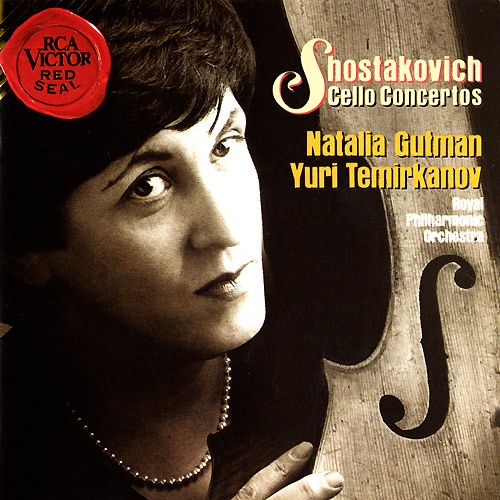
Music Composed by
Dmitri Shostakovich
Played by the
Royal Philharmonic Orchestra
With
Natalia Gutman
Conducted by
Yuri Temirkanov
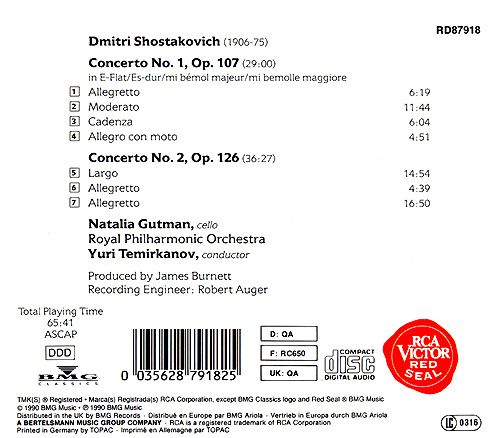
"Natalia Gutman has been appearing with great success for some years outside her native Russia,
but until now we have heard few of her recordings in the West. This ideal coupling of the two
Shostakovich cello concertos brings fresh, clean-cut readings, totally assured and marked by
many moments of poetry. Well-recorded in Watford Town Hall in north-west London, this would
be a natural recommendation, but for the existence of the formidable rival listed above. I cannot
disguise the fact that Schiff (Philips), accompanied by the composer's son, gives more bitingly
dramatic readings, consistently more powerful, using a wider range of tone and dynamic, with
Schiff's instrument warmer and fuller-sounding.
There are passages where Gutman scores with a deeper sense of repose, as at the end of the
opening cadenza in the finale of Concerto No. 2, leading into the rocking rhythm of the main Allegretto
(fig. 73: track 7, 2'06''), but they are the exception. In slow movements as in fast, Schiff tends to
find a darker, deeper intensity, a keener sense of purpose, as in the entry of the cello in the second
movement of No. 1. Gutman uses a warm vibrato there, where Schiff captures a rarefied, ethereal
quality. Yuri Temirkanov, less idiosyncratic here than he tends to be in nineteenth-century Russian
music, draws fine playing from the RPO, and so soon after reviewing the new Ashkenazy version of
the Britten Serenade (RPO/ASV�see page 1371), I am glad to note again the brilliant, rich-toned
playing of the RPO first horn, Jeffrey Bryant again. Particularly in Concerto No. 1 as he has such a
prominent solo role, he should have a separate credit.'"
Edward Greenfield, Gramophone
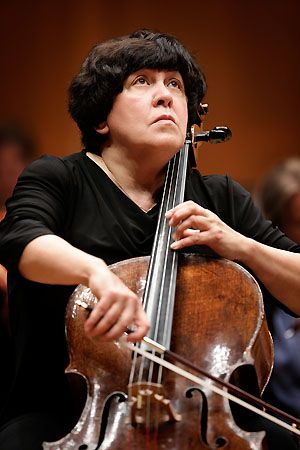
DOWNLOAD LINK - https://mega.co.nz/#!i0w1jRLY!oSj70ZBbn9jMCYHHcZ-Xo8KGDtUFKOVUM4mNECrR-9s
Source: RCA/BMG Classics CD, 1990 (my rip!)
Format: FLAC(RAR), DDD Stereo, Level: -5
File Size: 263 MB (incl. artwork, booklet, log & cue)
Enjoy! Don't share! Buy the origina! Please leave a "Like" or "Thank you" if you enjoyed this! :)
clean-cut readings, totally assured and marked by many moments of poetry."
EAC-FLAC link below. This is my own rip. Complete artwork,
LOG and CUE files included. Do not share. Buy the original!
Please leave a "Like" or "Thank you" if you enjoyed this!
Dmitri Shostakovich composed the Cello Concerto No.1 in July 1959 and Mstislav Rostropovich introduced it
at Leningrad on October 4, with Yevgeny Mravinsky conducting. It is lightly scored for double winds, piccolo, contrabassoon,
a single horn (no other brass), timpani, celesta, and strings.
Although a prolific composer in other forms, Shostakovich wrote only six concertos. If those for keyboard seem prevailingly
saucy and sun dappled, the four string concertos are somberly serious. Where there's any laughter at all, it sounds forced
and hollow. To lighten it (or try) only reinforces the "holy fool" (yurodivy) analogy that haunts Solomon Volkov's
Testimony, the posthumously alleged Memoirs of Dmitri Shostakovich.
When the First Cello Concerto was written with almost Mozartean speed, Stalin had been dead six years but not forgotten.
In 1958 Boris Pasternak was forced to decline a Nobel Prize for his anti-Stalinist novel, Doctor Zhivago, and then
was expelled from the Writers' Union. Ian MacDonald, in The New Shostakovich, concluded that Pasternak's humiliation
and subsequent persecution significantly influenced the First Cello Concerto. Volkov, on the other hand, gave no hint,
nor did Elizabeth Wilson in A Life Remembered. Most of what she included, anent the concerto, was Rostropovich's
celebration of himself, with this notable exception: "In the First Cello Concerto [M.R. speaking], Shostakovich alludes
to Stalin's favorite song, 'Suliko.' These allusions are undoubtedly not accidental, but...are camouflaged so craftily
that even I didn't notice them to begin with. The first time Dmitry Dmitriyevich hummed this passage through to me
[from the concluding rondo movement], he laughed and said, 'Slava, have you noticed?'"
Cello Concerto No. 1 is a major-key work in minor keys more often than not, recalling the mature Schubert's
subtle modulations. It was his first large-scale undertaking after the Eleventh Symphony a year earlier and one
of the works he quoted in his autobiographical Eighth String Quartet of 1960.
Shostakovich's last major work before his first heart-attack -- his first intimation of his own mortality -- was the
Second Cello Concerto. Composed in the early months of 1966, the Cello Concerto seems to have started
life as what Shostakovich called his Fourteenth Symphony. In the event, however, the work evolved into the
concerto, although the work's symphonic character was so pronounced that Shostakovich wrote to his friend Isaak
Glikman "...that the Second Concerto could have been called the Fourteenth Symphony with a solo cello part"
(Shostakovich, A Life, Laurel Fay, p. 247).
Although the work was conceived and composed prior to the deterioration of his health, the Second Cello
Concerto is, for the most part, a dark and ominous work with a long and introspective opening Largo and a
counter-balancing Allegretto finale, which is a sort of dusky barcarolle. Indeed, the work ends with the curious
"clock-work" percussion which closed the Fourth Symphony of 1935 and which would close the Fifteenth and final
symphony of 1971. Yet the work is not all gloomy: the central movement, also an Allegretto, is based in part
on a popular song of the '20s, "Pretzels, Who'll Buy my Pretzels?" Apparently, Shostakovich and some of his
close friends saw in the New Year of 1966 with a game of "Name that Tune" and Shostakovich played that tune
which he said was one of his favorites. One of the party guests was the cellist Mstislav Rostropovich, the
dedicatee and first performer of the Second Concerto.
Scored for pairs of winds with double bassoon, a pair of horns and of harps, plus a large percussion section,
Shostakovich's Second Concerto is a darkly lit work with flashes of light. The outer movements are rhapsodically
composed around pivotal climaxes and the central movement is a sardonic scherzo of a type that Shostakovich
had been writing since his E flat major Scherzo of 1923 - 1924. The lack of display for the soloist and the
inward nature of the music has denied the Second Cello Concerto the popularity of the First Concerto of 1959;
nevertheless, it is a great, if underappreciated, work.

Music Composed by
Dmitri Shostakovich
Played by the
Royal Philharmonic Orchestra
With
Natalia Gutman
Conducted by
Yuri Temirkanov

"Natalia Gutman has been appearing with great success for some years outside her native Russia,
but until now we have heard few of her recordings in the West. This ideal coupling of the two
Shostakovich cello concertos brings fresh, clean-cut readings, totally assured and marked by
many moments of poetry. Well-recorded in Watford Town Hall in north-west London, this would
be a natural recommendation, but for the existence of the formidable rival listed above. I cannot
disguise the fact that Schiff (Philips), accompanied by the composer's son, gives more bitingly
dramatic readings, consistently more powerful, using a wider range of tone and dynamic, with
Schiff's instrument warmer and fuller-sounding.
There are passages where Gutman scores with a deeper sense of repose, as at the end of the
opening cadenza in the finale of Concerto No. 2, leading into the rocking rhythm of the main Allegretto
(fig. 73: track 7, 2'06''), but they are the exception. In slow movements as in fast, Schiff tends to
find a darker, deeper intensity, a keener sense of purpose, as in the entry of the cello in the second
movement of No. 1. Gutman uses a warm vibrato there, where Schiff captures a rarefied, ethereal
quality. Yuri Temirkanov, less idiosyncratic here than he tends to be in nineteenth-century Russian
music, draws fine playing from the RPO, and so soon after reviewing the new Ashkenazy version of
the Britten Serenade (RPO/ASV�see page 1371), I am glad to note again the brilliant, rich-toned
playing of the RPO first horn, Jeffrey Bryant again. Particularly in Concerto No. 1 as he has such a
prominent solo role, he should have a separate credit.'"
Edward Greenfield, Gramophone

DOWNLOAD LINK - https://mega.co.nz/#!i0w1jRLY!oSj70ZBbn9jMCYHHcZ-Xo8KGDtUFKOVUM4mNECrR-9s
Source: RCA/BMG Classics CD, 1990 (my rip!)
Format: FLAC(RAR), DDD Stereo, Level: -5
File Size: 263 MB (incl. artwork, booklet, log & cue)
Enjoy! Don't share! Buy the origina! Please leave a "Like" or "Thank you" if you enjoyed this! :)
